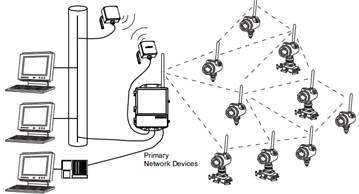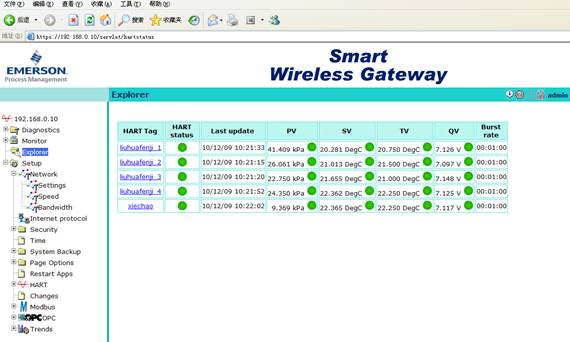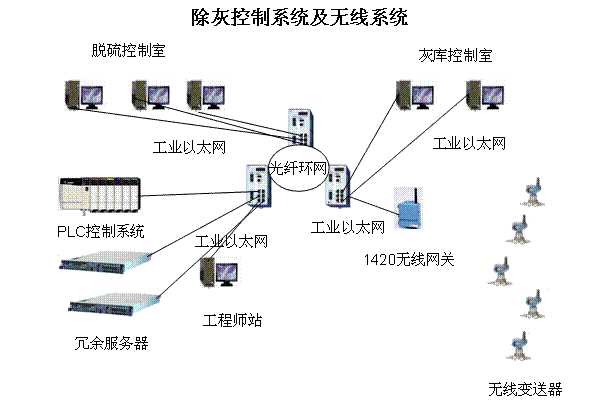Application of Intelligent Wireless Technology in Ash Removal System of Power Plant
1 System Overview
The ash removal system of Huaneng Shanghai Shidongkou No. 1 Power Plant is mainly composed of ash pumping ash and ash storage, and the system control is completed by PLC. Due to historical reasons, the ash removal control system was not originally under the jurisdiction of thermal control, the system design concept is outdated, there are few analog signals, and the level of automation is low.
In 2008, the thermal control major reformed the ash removal control system, and the control range included the pneumatic ash delivery, ash storage, and mortar systems of the four furnaces. The HMI part of the host computer is changed to a standard client / server structure, and six clients are configured.
Two redundant servers, an engineering station and a database server. The operating personnel operate on the client, the screen is provided by the server, and the engineering station modifies the program and screen. As long as any modification is completed in the engineering station, the operator can update the operation screen as long as the screen is switched, without restarting the computer.
In order to improve the automation level of the ash removal system, after this round of transformation, the thermal control professional set out to perfect the local equipment. However, due to the low level of automation of the original ash removal system and long-term manual operation by the operating personnel, it was not possible to put forward control requirements on field equipment. Therefore, by observing the local equipment, we decided to increase the pressure difference signal of the top fan of the warehouse, the pressure signal of the fluidized fan at the bottom of the warehouse and the fluidized fan of the chute.
2 Introduction to Application Engineering
With the rapid development of science and technology, in recent years, wireless technology has been greatly developed, and many wireless devices have appeared in the field of process control, such as wireless pressure, differential pressure transmitters, temperature transmitters, and wireless positioners. Emerson's smart wireless technology is one of them. Huaneng Shanghai Shidongkou No. 1 Power Plant's thermal control department has always been concerned about new technologies. Considering that this transformation is indeed difficult to lay cables on the ash bank, it was decided to try a new technology such as wireless. Because power plants generally use Emerson's Rosemount transmitters, we chose Rosemount wireless transmitters this time. Emerson provided wireless transmitters and related equipment at a reasonable price.

The wireless hardware consists of a wireless transmitter and a wireless gateway 1420. The visible distance between a single wireless device can reach 228 meters. There is a wired connection between the wireless gateway and the host control system. The communication methods are Modbus 485, Modbus TCP / IP and OPC . The above is a schematic diagram of the wireless technology solution provided by Rosemount. The transformation plan of the entire field device was originally designed with nine transmitters, and later only five units were used due to changes in the design scheme. After the equipment arrived, the installation and commissioning of the entire wireless equipment system was completely completed by the thermal control engineer. During this period, only relevant technical personnel of Emerson were consulted on related technical issues. So far, we have made the first wireless model project in Shanghai's power system.
3 Wireless communication and system security
3.1 Wireless frequency
There are three commonly used ISM frequency bands related to the process industry: 900MHz, 868MHz and 2.4GHz. The 900MHz frequency is most commonly used in the United States, the 868MHz frequency band can be used for ISM communications in most parts of Europe, and the 2.4GHz frequency band is applicable worldwide. The 2.4GHz frequency band actually includes the range from 2.4GHz to 2.4835GHz, and at the same time, the 2.4GHz frequency band is also a Wi-Fi working frequency band. Smart wireless technology works in this frequency band.
3.2 Wireless network reliability and security
A major feature of smart wireless technology is the use of self-organizing mesh topology, rather than the common point-to-point structure. In the point-to-point topology, each device communicates directly with the gateway, and the communication path between the device and the gateway needs to be fully visible, which is more difficult to achieve in the field; in the mesh topology, each wireless device It can be used as a relay route for other wireless devices, and there is no need for complete visibility between the device and the gateway. At the same time, the self-organization feature ensures that each device in the network has at least two communication paths. Once one of the communication paths is interrupted for some reason, the network will automatically use the other paths for communication, thus ensuring smart wireless technology in complex It is still reliable in the factory environment.
Smart wireless technology divides the 2.4GHz frequency band into 16 narrower frequency bands and uses frequency hopping technology. If interference is detected in one of the frequency bands, the network communication will switch to another frequency band. At the same time, smart wireless technology has built-in data encryption and verification, identity verification is also required between the sending device and the receiving device, and data access also requires corresponding permissions.
In addition, it is worth mentioning that the smart wireless field devices are completely powered by batteries, which benefits from the low power consumption of the field devices, so that the wireless device can continue to work in the field for several years without replacing the battery. Secondly, the battery it uses contains many patents, has many features such as intrinsic safety, short circuit prevention, etc., and can be replaced at will in a hazardous environment without taking special safety measures.
4 Implementation plan
4.1 Connection of the manufacturer's own system
The intelligent wireless network consists of a wireless transmitter and a 1420 wireless gateway. After completing the simple configuration and installation of the field equipment, the 1420 gateway is connected to the 24VDC power supply, the transmitter is installed with the battery, and the entire wireless network can be automatically online.
4.2 Connection of wireless and control system
The 1420 wireless gateway is the interface between the wireless device and the existing control system. The connection from the gateway to the host can be accessed in a variety of ways, mainly Modbus RS485, Modbus TCP / IP or OPC. The reformed ash removal control system uses Rockwell AB series PLC, and the human-machine interface part is Rockwell FactoryTalk View universal HMI solution. Since there is no free 485 interface in the AB series PLC, we use OPC communication for this solution.
5 Wireless network configuration
The configuration of the wireless network is relatively simple, divided into two parts: the configuration of the field device and the configuration of the gateway. The configuration of the field device is mainly the configuration of Join Key, Network ID, and data refresh rate. Join Key and Network ID are the handshake password and network identification that communicate with the wireless device. The default value of the wireless gateway can be used. The data refresh rate is based on the actual Need to be sure. The setting of these parameters can be done through the HART 375 handheld terminal that supports the wireless version, or it can be set in the wireless configuration software provided with the device.
The configuration of the gateway needs to be logged in from the laptop to the 1420 gateway. It should be noted that the direct connection between the laptop and the gateway requires the use of the randomly equipped crossover network cable. The login address of the gateway is its IP address, and the default is https://192.168.1.10. After entering the user name and password, you can modify the IP address as needed. Generally speaking, there is no need to change the IP address, but for integrating the gateway into the existing Ethernet network, the gateway IP address needs to be changed to the vacant in the corresponding network segment IP address. In the PLC control system, the system server's IP addresses are 192.168.0.1 and 192.168.0.3, and the client's address is 192.168.0.5. Therefore, we changed the wireless gateway IP address to 192.168.0.10.

6 Integration of wireless products and control systems
The embedded software of Emerson Smart Wireless Gateway (version 3.8.9), the setting and browsing of the gateway and the wireless system are carried out through the IE browser. No other software is required. Set the IP address to 192.168.0.10 in Setup—> Internet protocol respectively. Set the instrument parameters in Setup—> HART, and set the variables to be mapped and uploaded to the host computer in Setup—> OPC. The whole process is relatively simple.
On the side of the AB series PLC control system, just create a new OPC in the HMI software FactoryTalk View Studio, and select EmersonProcess.GatewayOPCServerDA.3, run Tag Browser in FactoryTalk View Studio, create a new tag point and create a new tag point in the gateway OPC (As shown below: Tag point in 192_168_0_10) Connect and configure the HMI screen to display the measured value correctly.
The following is the modified control and wireless system diagram


7 Application and evaluation of wireless products
Emerson's wireless products have commonly used pressure, temperature, flow, liquid level (material level) transmitters, analytical instruments and positioners, etc., which basically cover the commonly used measurement signals of thermal control. The advantages of wireless products are obvious. The first is the cost savings, labor, cable and threading tube and other on-site construction costs. There is no need to purchase analog cards, and the construction and commissioning time is greatly shortened.
Users must first be familiar with their own control system, and users have the right to choose the products they like familiar with. For the automation industry, some of the functions that this company ’s products can provide can also be provided by other companies. The most critical point is how we can use these products correctly and flexibly, broaden our thinking, and bring the level of automation to a higher level. floor.
From a security point of view, since they are all used in a small area, there are no more than 100 units, and no complex and diverse wireless network redundancy scheme is required. It is recommended that the wireless gateway be placed closer to the receiving device and slightly away from the control system.
Wireless technology is currently mainly used for unattended signal monitoring and thermal experiments in power systems. Of course, wireless technology has not been widely adopted in factories so far. People are worried about the reliability, safety, and battery life of wireless systems. Even in the case of high cost of traditional wired technology solutions, they are not willing to take risks to apply new products.
8 Future Outlook
With the emergence and development of wireless equipment and wireless power output technology, people have worried that these new technologies have been widely used, more and more recognized, and even gradually strengthened as a standard.
The emergence and development of the Internet has also driven the demand and dependence of society, families and automatic control on the Internet. The Internet has changed from 2G to 3G, and this situation has changed accordingly. In operations in many fields, people are turning their attention to wireless technology, and in the future wireless technology will be widely applied to various products.
Coaxial Power Cable,Coaxial CCTV Cable,Fireproof Coaxial Cable,Siamese Cable
Huayuan Gaoke Cable Co.,Ltd. , https://www.bjhygkcable.com